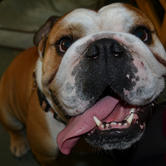Bulldog Separation Anxiety and How to Fix It

Bulldogs thrive in social situations. Sometimes that can’t happen though, and your pup doesn’t understand. So it should be no surprise that it screams and weeps when left in a crate. However, on top of that, once when in a rush you left your favorite shirt on the floor near the crate and returned home to find it shredded. So you let the pup out, thinking it’s just the crate that’s the problem. When you leave the house and come back your couch has been eaten. Your pup (and you) is suffering from separation anxiety. While it may be too late for your couch, it’s not too late to fix your pup.
Crate Training Is Key
Crate training is the best way to both house train a dog and help with social anxiety. Dogs are den animals, and are comfortable being in small, dark, warm and comfortable places. What they don’t like about the crate isn’t the cage part, but the fact that they don’t have the body heat all around them that they were used to in their litter. Don’t give up on the crate when dealing with a puppy with separation anxiety. It’s the best way to keep your house in-tact and your panicked puppy in a safe, controlled environment while you’re gone.
Make it Comfortable
Making the crate comfortable and fun will help the puppy see it as a positive and not a negative. Put some fun safe toys in the crate for the pup and hide some treats in there. This is just the first step of ridding the pup of separation anxiety.
Ignore the Screaming
This is the most difficult part, understandably so, but it’s also the most important. When your puppy is screaming and crying for you, it’s asking for attention. When you give it attention in any form, yelling, talking, eye contact, or letting it out, you’re positively reinforcing that behavior. Instead, ignore the puppy to teach it to self soothe. This will also teach you to self soothe as this can be an extremely trying time for you.
Let the Puppy Out Only When Calm
Only let the puppy out when it’s completely calm. Just because your puppy isn’t whining doesn’t mean it is calm. It should be still and sitting, laying, or standing calmly in the crate waiting patiently for you to let it out. Anything is the same form of positive reinforcement as when the pup is screaming for you.
Make Coming and Going a Normal/Calm Experience
Are you the owner that shows your puppy a ton of love as soon as you walk in and/or out of the door? It’s extremely endearing, but it’s not healthy for your pup. Your puppy gets anxious because it thinks that you coming and going is a big deal. It probably even thinks you’re not going to come back home. You’re going to forget about it. You coming and going shouldn’t be a big deal, so you shouldn’t treat it like one and you should stop your pup from treating it like one too. Do this by ignoring the puppy when you first enter the house aside from routine things. Wait until your pup calms down before you show it affection.
Doing all of these things will help you to slowly begin to change the level of social anxiety in your pup. Your primary goal is to teach the pup to self-soothe instead of depend on you and your presence as its only form of soothing. You should make sure your pup has plenty of toys and distractions from you around so it always has something else to turn to. You should always treat coming and going as a routine, calm situation so they come to expect and accept it.
Photo credit: Rob Witcher/Flickr







